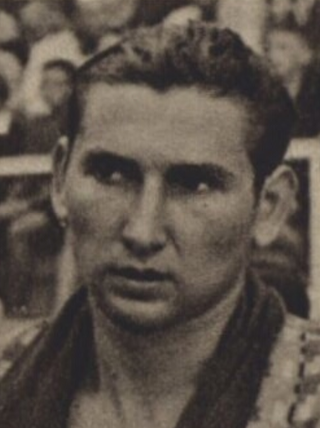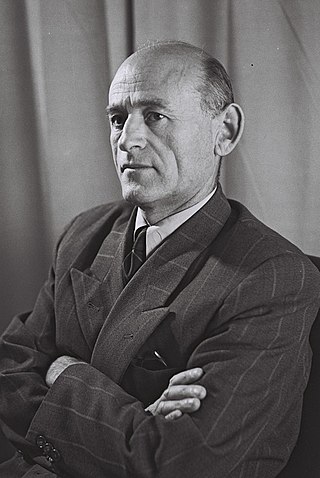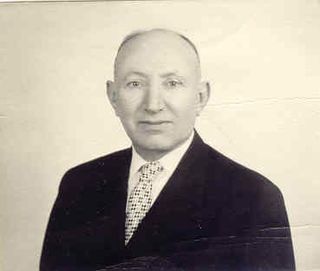Related Research Articles

Duo Datz is a group comprising Orna and Moshe Datz. A musical duo in Israel for audiences of all ages, they were also introduced to European audiences by scoring a third place for Israel at the 1991 Eurovision Song Contest.

Tell Qasile is an archaeological site near the Yarkon River in Tel Aviv, Israel. Over 3,000 years old, the site contains the remains of a port city founded by the Philistines in the 12th century BC.

Esther Vilenska was a Lithuanian Jewish Israeli communist politician, journalist and author who served as a member of the Knesset for Maki between 1951 and 1959 and then again from 1961 to 1965.

Pavol Steiner, also Pavel Steiner and Paul Steiner was a Slovak Olympic water polo player and swimmer representing Czechoslovakia. He was also a cardiology surgeon. Steiner competed in the 1928 Summer Olympics in water polo, won a bronze medal at the 1931 European Aquatics Championships in swimming, and won five swimming gold medals and one water polo gold medal combined at the 1932 Maccabiah Games and 1935 Maccabiah Games in Mandatory Palestine.

Meir Argov was a Zionist activist, Israeli politician and a signatory of the Israeli declaration of independence.

Kfar Glikson is a kibbutz in northern Israel. Located near Binyamina and Pardes Hana-Karkur, it falls under the jurisdiction of Menashe Regional Council. In 2022 it had a population of 356.

Kfar Uria is a moshav in central Israel. Located near Beit Shemesh in the Shephelah. It falls under the jurisdiction of Mateh Yehuda Regional Council. In 2022 it had a population of 910.

The Justice Ministry is the Israeli government ministry that oversees the Israeli judicial system.

The East Jerusalem Central Bus Station is a transportation hub serving Arab neighborhoods in the city of Jerusalem and other locations in the West Bank. It is located on Sultan Suleiman Street across from the Old City's Damascus Gate, as well as the Damascus Gate light rail station for Jerusalem's Red Line.
Manfred Aschner was an Israeli microbiologist and entomologist. Recipient of the Israel Prize in Life Sciences. He was a professor in the Faculty of Biotechnology and Food Engineering at the Technion.

Bank of Jerusalem, Ltd is Israel's seventh-largest bank, with total assets of 9,301 million shekels. Bank of Jerusalem is headquartered in Jerusalem and has 25 branches around the country.
Hannah Bat Shahar is an Israeli writer.

Shmuel Mikunis was an Israeli politician. He was a member of the Knesset for the Maki and Moked (1973–1974) parties.

Leopold Krakauer was an architect and a painter. He was one of the most prominent architects who worked in Israel in the mid-twenties. He was also a painter who presented drawings and paintings at exhibitions in Israel and all over the world. Krakauer lived in Israel from 1924 until his death.

The Plurinational State of Bolivia and the State of Israel first established a diplomatic relationship with each other in 1950, two years after the Israeli Declaration of Independence and one year after Bolivia recognized Israel's sovereignty. Both countries enjoyed generally stable and close ties until the beginning of the 21st century, when successive Bolivian governments became vocally opposed to Israeli military operations against Hamas in the Gaza Strip. Under the Bolivian political party Movement for Socialism, which has governed the country on a near-continuous basis since 2006, Bolivia has adopted an increasingly pro-Palestinian stance at the United Nations with regard to the Israeli–Palestinian conflict, eliciting a negative response from the Israeli government.

Yona Fischer was an Israeli art curator and art critic. Winner of the Israel Prize for Design for the year 1977.

Tzvi Ayalon was a Haganah leader and a major general (Aluf) in the Israel Defense Forces, he served as the first Deputy Chief of General Staff as well as the commander of the Central Command (Israel). After his military service he served as the deputy director-general of the Ministry of Defense (Israel) and Ambassador of Israel in Romania.
Moshe Halevi (1895–1974) was an Israeli theatre director, founder of the Ohel theatre.
The Israel Philatelic Federation is an association whose purpose is to nurture and promote philately in Israel.

Mordecai Margalioth (Margulies) (13 October 1909/28 Tishrei 5670–24 March 1968; Hebrew: מרדכי מרגליות) was a scholar of the Talmud, Midrash and Geonic literature. He was a professor at the Hebrew University of Jerusalem and at the Jewish Theological Seminary of America.
References
- ↑ "Maurice Fischer, Israel's Ambassador to Rome, Dies at 62". Jewish Telegraphic Agency. August 20, 1965. Retrieved 9 August 2020.
- ↑ Lamdan, Neville; Melloni, Alberto. (eds.) (2007). Nostra Aetate. LIT Verlag. pp. 33–34. ISBN 978-3-8258-0678-1.
- ↑ Zamir, Meir (June 25, 2008). "The French Connection". Haaretz. Retrieved 9 August 2020.
- ↑ "Turkey". Israel Ministry of Foreign Affairs. Retrieved 17 May 2020.
- ↑ "Italy". Israel Ministry of Foreign Affairs. Retrieved 20 May 2020.
- ↑ "קראו בכותר - מבט מל"מ : כתב עת לענייני מודיעין ובטחון מבית המרכז למורשת המודיעין - גיליון 80". kotar.cet.ac.il. Retrieved 2025-01-19.
- ↑ "צירי ישראל הגישו כתביאמנה בלונדון ובפאריס — דבר 6 יולי 1949 — הספרייה הלאומית של ישראל │ עיתונים". www.nli.org.il (in Hebrew). Retrieved 2025-01-19.
- ↑ "מ. פישר - השגריר באיטליה — הארץ 14 נובמבר 1960 — הספרייה הלאומית של ישראל │ עיתונים". www.nli.org.il (in Hebrew). Retrieved 2025-01-19.
- ↑ "מו1ר*ס פישר מוז בעווו"ץ היה שגריר ישראל באיטליה — מעריב 20 אוגוסט 1965 — הספרייה הלאומית של ישראל │ עיתונים". www.nli.org.il (in Hebrew). Retrieved 2025-01-19.